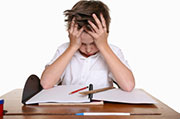
MONDAY, Sept. 29, 2014 (HealthDay News) — Attention-deficit/hyperactivity disorder can harm a child’s academic performance and social skills as early as the second grade, a new Australian study contends.
Children between 6 and 8 years old who were tested and scored high for ADHD symptoms were more likely to get lower grades in elementary school and have trouble fitting in with other kids, compared with children without ADHD, the study authors reported.
Kids with ADHD also were more likely to have other mental health or developmental disorders, including anxiety, depression and autism, according to the study.
“Already at this stage, which is relatively young, it’s very clear the children have important functional problems in every domain we registered,” said study lead author Dr. Daryl Efron, a developmental-behavioral pediatrician with the Royal Children’s Hospital Melbourne. “On every measure, we found the kids with ADHD were performing far poorer than the control children.”
The researchers also said they discovered that about 80 percent of the young children with ADHD symptoms had not been diagnosed with the disorder, a finding called “striking” by Dr. David Fassler, a clinical professor of psychiatry at the University of Vermont College of Medicine.
“For this reason, I would fully agree with the authors’ conclusion that the results of the study underscore the need for earlier recognition and treatment of ADHD in young children,” Fassler said.
The study, published online Sept. 29 in the journal Pediatrics, is one of the first reports from the Children’s Attention Project, a long-term examination of ADHD funded by the Australian government.
The researchers tested nearly 400 children between 6 and 8 years of age at 43 Melbourne schools, identifying 179 with ADHD and another 212 without ADHD who will serve as a “control group.” These children will be observed throughout their academic careers.
By the second grade, the children with ADHD were already struggling. They were more likely to score below-average in reading and mathematics, and more likely to have problems connecting socially with their peers, the researchers said.
For example, 33 percent of kids with ADHD were reading below average and 46 percent had math skills below average. For non-ADHD kids, only about 6 percent were reading below average and nearly 15 percent had below-average math skills, the researchers found.
And the ADHD children were more likely to have other mental health or developmental problems — such as anxiety, obsessive-compulsive disorder, depression, mania and autism, said Efron, who’s also a senior lecturer at the University of Melbourne.
“Some people think it’s only when kids get older you can pick up these comorbidities [overlapping health issues]. But we’ve shown you can pick them up at this early stage if you are looking for them,” he said.
What’s more, these problems seem to accumulate in some kids with ADHD, with 30 percent having two such impairments and 24 percent having three. By comparison, about 6 percent of non-ADHD kids had two such impairments, and about 1 percent had three, according to the study.
The investigators found that boys and girls with ADHD were equally impaired by the disorder.
“There hasn’t been that much research into girls with ADHD, so we don’t know that much,” Efron said. “When we do see girls, in my experience, they are as impaired as the boys. But it is a novel research finding.”
In another study published in the same issue of Pediatrics, researchers presented disappointing results for a drug that some had hoped would ease the insomnia experienced by many children with ADHD.
The drug, eszopiclone, failed to help children aged 6 to 17 with their ADHD-related insomnia. Both low and high doses of the drug proved ineffective, the researchers found.
More information
To learn more about ADHD, visit the U.S. National Institute of Mental Health.
Copyright © 2025 HealthDay. All rights reserved.

